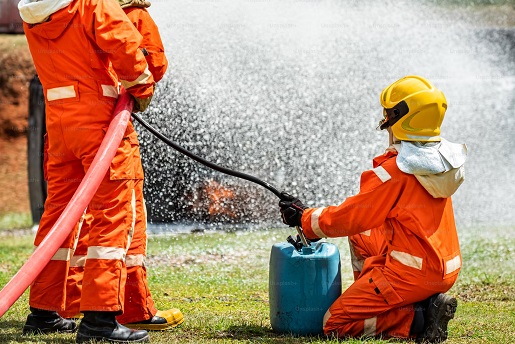Imagine a scenario–buildings gutted in roaring blazes and covered in thick smoke. The firefighters, all geared up, are putting their lives at risk to douse the fire and evacuate survivors. But, imagine their plight when they get diagnosed with life-threatening health conditions, albeit, because of their livelihood.
This is the chilling reality facing countless firefighters across the nation. They are grappling with the potency of a toxin found in the fabric of their suits and the firefighting foam – the insidious threat of PFAS chemicals.
For decades, firefighting foam was a mainstay in the operations of firefighters around army bases and airports. But, as a shocking piece of reality, the firefighting gear and the aqueous film-forming foam(AFFF) used to put down fires contained PFAS chemicals (per-and-poly fluoroalkyl substances.)
Dubbed “forever chemicals”, PFAS chemicals remain undegraded for decades in the environment and can accumulate in the human body. From various cancers to thyroid-related and immune system complications, the potency of these toxins is unnerving.
The grim situation is about families of our heroes shattered by unexpected diagnoses, about the arduous battles against illness. Today, as a community we should demand accountability from those prioritizing profit over safety. The firefighter foam lawsuit is a testament to society’s unwavering spirit, a beacon of hope in the face of adversity.
In this blog post, we will explore the hazards of PFAS found in the gear and the foam, the devastating health risks it poses, and the legal fight for compensation for brave hearts and their families.
AFFF, Firefighting Gear, and PFAS
AFFF or aqueous film firefighting foam is used in fires caused by flammable liquids such as oil, gasoline, and jet fuel. When the foam mixes with water, it forms a film that cuts off oxygen flow to the fire and puts it out.
Even though it has proved to be more than effective in fighting fires, many studies now claim that AFFF contains PFAS chemicals which are carcinogenic.
Firefighter turnout gear consists of pants and a jacket, each having three layers: an outer casing, a moisture barrier, and a thermal liner. Outer shell fabric must meet water absorption standards. Lauded for their water and heat resistance, PFAS chemicals are employed to meet these standards.
These chemicals form a durable barrier against flames, molten metals, and chemical splashes, enhancing firefighter safety. However, their very persistence, which seems advantageous, has become a cause for global concern.
PFAS exposure has a history of litigation. As stated by TorHoerman Law, cases such as Malone v. Stanley Black & Decker Inc., have revealed companies that have distributed products containing high levels of PFAS even when they knew about the associated hazards.
Another case of corporate dishonesty unfolded in the legal proceedings involving DuPont and 3M, among other entities, accused of providing false information about hazardous products.
Unveiling the Complexities of PFAS Exposure
Research from Harvard and the US Centers for Disease Control and Prevention (CDC) paints a startling picture: There are more than 4000 distinct PFAS variants in the environment. This indicates the scope and potential dangers of this potent family of chemicals.
Although not all PFAS substances are toxic, the implications of exposure are chilling, nevertheless.
According to the National Library of Medicine, a 2019 study conducted in Washington State unveiled that a few variants within the PFAS group were identifiable in around 90% of breast milk samples from lactating women.
While cancer often takes center stage in the discussion of PFAS contamination, the hidden dangers of these “forever chemicals” are far-reaching. A long-term study of almost 70,000 individuals living near a DuPont plant linked PFOA, a specific PFAS chemical, to a disturbing spectrum of potential consequences:
Beyond Cancer: Although increased cholesterol and renal carcinomas bring about some frightening considerations, the catalog does not stop at cancerous diseases.
PFAS exposure is linked to a variety of conditions such as ulcerative colitis, thyroid disorders, testicular cancer, and even high blood pressure in pregnant women.
Thyroid Dysfunction: A 2012 study published in the Journal of American Medical Association reflects another ominous truth. It shows a concerning association between elevated PFAS concentrations and greater potential for hypothyroid in women, demonstrating the danger these chemicals pose to hormonal health.
Risks to Newborns: Compelling evidence underscores the impact of PFAS exposure on newborns and expectant mothers. These chemicals can disrupt cognitive function, contributing to attention deficits in developing children.
Furthermore, this class of chemicals has also been associated with an increased incidence of gestational diabetes and preeclampsia. Studies also indicate a probable link between prenatal exposure to PFAS and reduced birth weight.
PFAS contamination is not a temporary scare. These chemicals have seeped deep into our ecosystem. Even though their use has reduced considerably, they continue to exist in our environment.
From impaired fetal development to hormonal imbalances and beyond, the shadow cast by these “forever chemicals” demands our immediate attention and action.
Firefighters, Foam, and the Fight for Justice
For firefighters, their livelihood is a swirling vortex of flames, searing heat, and the ever-present threat of unseen toxins.
This section delves into the legal battle that has been fueled by the disproportionate exposure of firefighters to PFAS chemicals, and the alleged negligence of those who failed to warn them about the hidden risks.
Due to the nature of their profession, firefighters have been exposed to PFAS for decades. This exposure primarily occurs through:
Direct Contact: This is by far the most effective route for the toxins to enter the bloodstream of firefighters. They stand a high chance to come into direct contact with PFAS-laden foam during their training and fire suppression activities. This leads to absorption through the skin and airway.
Contaminated Gear: Turnout gear, designed to protect firefighters from flames and heat, can be another persistent source of exposure. The different layers of the suit and the pants can be laden with varying levels of PFAS variants.
Environmental Contamination: Fire stations and training grounds contaminated with PFAS from repeated foam use likely become secondary sources of exposure, lingering in dust and even drinking water.
This constant exposure has put firefighters at a higher risk of developing PFAS-induced health problems compared to the general population.
Negligence Claims: Pointing the Finger:
The legal battle against PFAS exposure hinges on claims of negligence against two primary entities:
Manufacturing Giants: Court cases involve claims that manufacturers were aware or ought to have been aware of the potential health risks associated with PFAS in foam and equipment. The litigations claim that these bigwigs failed to warn firefighters, promote safer alternatives, or provide appropriate protective equipment.
U.S. Government: Environmentalists claim that the government acted negligently in terms of setting proper guidelines for safe PFAS levels. The claims suggest that the authorities in power turned a blind eye even after an extensive body of evidence emerged attesting to possible health risks.
Current Landscape: A Battleground in Flux
The specter of PFAS, the “forever chemicals” lurking in our environment and bodies, has begun a seismic legal response as the true extent of their health risks comes to light.
On August 26, 2022, the proposed re-classification of PFOA and PFOS as Superfund hazardous substances under CERCLA caused tremors in the industry. This step became a harbinger for litigations, holding the manufacturers accountable for their negligence.
Mounting Lawsuits and Mounting Liabilities:
The high number of AFFF firefighting foam lawsuits has revealed an intricate network of more than two dozen companies that are responsible for the widespread contamination.
Among them are legacy establishments like 3M Company, DuPont Co., Chemours Co., Tyco Fire Products, and ChemGuard Inc.. . These companies are now facing severe scrutiny.
Several victims have scored legal victories that provide a glimmer of hope amidst the sea of concerns. Here are some notable examples:
$50 Million for Testicular Cancer: In March 2020, a landmark lawsuit secured a $50 million compensation to a victim of testicular cancer. The brand in question was DuPont and the victim’s condition was linked to PFAS-contaminated drinking water near DuPont’s industry sites.
$671 Million West Virginia Settlement: In 2017, DuPont faced another major settlement, this time for $671 million to resolve hundreds of lawsuits arising from its dumping of PFAS into West Virginia’s waterways. This case highlighted the long-term environmental and public health repercussions of irresponsible chemical handling.
$54 Million for Michigan Residents: A 2023 class-action lawsuit involving PFAS contamination in Kent County, Michigan, resulted in a $54 million settlement shared by 3M and Wolverine Worldwide.
This victory demonstrates the growing awareness of the community-wide impacts of PFAS exposure and the collective power of holding corporations accountable.
Navigating the Storm: Resources and Support for Firefighters
Overcoming the consequences of PFAS exposure is a daunting task, but always bear in mind that you are not alone. There is a highly efficient network of resources and support organizations that stand ready to help you and your family navigate this challenging terrain.
Here are some vital contacts:
The International Association of Fire Fighters (IAFF): IAFF is willing to allocate the resources and offer legal support for firefighters affected by PFAS. You can visit their website for comprehensive information and guidance.
The National Fire Protection Association (NFPA): The NFPA provides education materials and standards on how to reduce PFAS exposure while carrying out firefighting operations. Their website will offer you more information regarding their resources.
The Environmental Protection Agency (EPA): The EPA has actively researched PFAS, including its health risks and potential mitigation strategies. It has also come up with a few policies that set standards for the safe levels of PFAS.
Conclusion
The pursuit of profit often disregards the calls for responsibility. This stark reality reverberates prominently in the case of firefighting, where chemicals once hailed as marvels now cast a looming shadow of health apprehensions.
Despite extensive marketing campaigns depicting a heroic narrative, concealed risks persist in everyday products.
Confronting this truth necessitates vigilance. Staying abreast of the dynamic landscape of AFFF contamination lawsuits can be a good starting point. This will serve as a shield against potential harm.
If you or someone you know is affected by AFFF contamination, seek legal counsel. Raising your voice will stand as a beacon of hope amid uncertainty.













